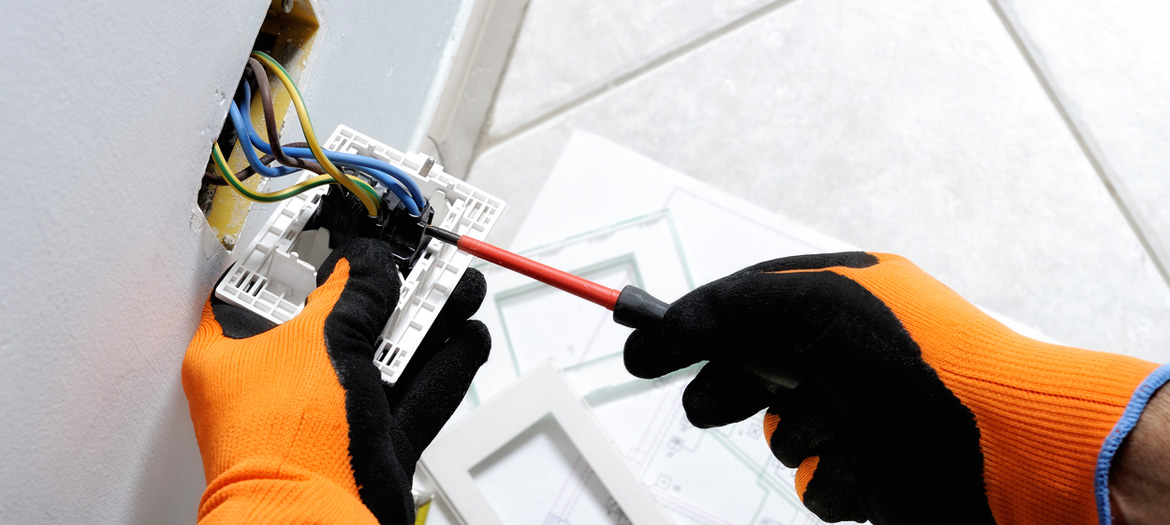Typical Electric Troubles Every Homeowner Need To Find out about
Property owners often run into various electrical problems that can impact safety and capability. Problems like flickering lights and tripped circuit breakers are more typical than numerous understand. These circumstances can show deeper electric worries that warrant interest. Recognizing the indications and risks associated with outdated circuitry and dead electrical outlets is important. What measures can be required to stop these problems? Discovering these common electric issues might disclose important understandings for maintaining a risk-free home setting.

Flickering Lights: Causes and Solutions
Why do some homeowners experience flickering lights? Flickering lights can be a typical annoyance, commonly showing underlying electrical problems. One key reason is malfunctioning or loose connections within lights or wiring, which can lead to recurring power supply. Furthermore, utilizing high-wattage devices on the same circuit may trigger voltage fluctuations, resulting in flickering or dimming. One more prospective concern is an overloaded circuit, where a lot of gadgets attract power simultaneously, straining the electrical system. Obsolete or abject electrical wiring can add to irregular electric circulation. Sometimes, flickering lights might indicate a trouble with the home's electric panel or service line. House owners must address flickering lights immediately to prevent prospective risks. Solutions might consist of tightening up connections, redistributing appliance lots, or consulting a certified electrician for an extensive analysis. Recognizing the origin cause can help assure a secure and secure electric system in the home.
Tripped Circuit Breakers: What You Required to Know
Have property owners ever questioned what causes their circuit breakers to journey all of a sudden? This typical issue commonly develops from an overload of electrical circuits, where way too many gadgets draw power at the same time. In such instances, the breaker acts as a safety and security device, disrupting the flow of electrical power to stop overheating and potential risks. An additional regular cause is a short circuit, which happens when a live cable calls a neutral cable, creating a rise of power that trips the breaker. Ground mistakes can additionally cause tripped breakers; these take place when a live wire touches the ground or a based surface, posing major safety and security threats. Property owners ought to on a regular basis evaluate their usage of high-wattage appliances to stay clear of overloading circuits. Furthermore, recognizing the feature of circuit breakers can aid them react appropriately throughout a journey, guaranteeing their home stays properly maintained and safe.
Out-of-date Wiring: Indications and Dangers
Outdated electrical wiring can present significant threats to house owners, usually going unnoticed up until troubles occur. Homes built before the 1980s might still have aluminum circuitry or knob-and-tube systems, which are no longer thought about risk-free. Signs of out-of-date circuitry include flickering lights, regularly tripped breaker, or burning scents near electrical outlets. These signs might recommend that the electric system is loaded down or deteriorating.Additionally, property owners might discover swelter marks around switches or electrical outlets, which can indicate overheating. The risk of electrical fires markedly enhances with out-of-date wiring, as these systems were not developed to manage modern-day electrical loads. Homeowners are urged to have their circuitry inspected frequently, especially when remodeling or including brand-new appliances. By recognizing these indicators early, they can avoid unsafe situations and preserve a safer living environment. Updating to current electrical criteria is a positive action in maintaining home safety and security and effectiveness.
Regularly Blown Fuses: Repairing Tips
Regular blown fuses can show underlying electrical issues that might come from out-of-date electrical wiring or overloaded circuits. Homeowners experiencing this problem must initially recognize the home appliances attached to the influenced circuit. It is recommended to stay clear of making use of multiple high-wattage gadgets at the same time, as this can cause circuit overload. If the issue lingers, examining the circuit box for signs of wear or damages is important; a defective fuse box may require replacement.Additionally, looking for loosened connections within the circuit can aid prevent future incidents. Property owners need to likewise confirm that the integrates being used are of the proper amperage, as making use of an incorrect fuse find out this here can worsen the problem. Speaking with an accredited electrical expert is recommended to assess the electrical system even more if these repairing suggestions do not deal with the problem. Attending to these concerns quickly can help reduce threats and assure the safety of the home's electrical framework.
Dead Outlets: Usual Causes and Fixes
When a home owner encounters a dead outlet, it can frequently provide disappointment and confusion. Several typical causes may result in this issue. One regular culprit is a stumbled breaker, which can be easily reset. If any kind of breakers are in the off setting, homeowners ought to inspect their electrical panel to examine. Another opportunity is a faulty electrical outlet itself, which may require replacement. Additionally, loosened electrical wiring links within the outlet can interrupt power circulation, making assessment essential.Sometimes, the issue might originate from an overloaded circuit, particularly when multiple tools are connected. In such situations, rearranging the electrical load can settle the concern. House owners ought to additionally consider the age of their circuitry; older systems may need updates to satisfy contemporary electrical demands. If these actions do not fix the circumstance, seeking advice from a certified electrician is recommended to guarantee safety and security and proper diagnosis.
Electric Shocks: When to Be Concerned
Exactly how can house owners determine whether an electric shock warrants concern? Home owners ought to first assess the intensity and context of the shock. A light static shock, frequently felt when touching steel objects, is usual and typically harmless. If the shock happens while engaging with a plugged-in device or outlet, it might indicate a much more severe issue.The place and frequency of the shocks are necessary. Repetitive shocks from the same source, especially in damp locations like restrooms or kitchen areas, might signify faulty wiring or poor grounding. Property owners must also consider the feeling of the shock; a jolt that causes discomfort or contraction is more startling than a mere tingle.If there's any type of uncertainty, it is a good idea to speak with a qualified electrical contractor. Overlooking possible electrical dangers can cause severe safety and security dangers, consisting of fire or serious injury.
Overloaded Circuits: Prevention and Precaution
Overloaded circuits posture substantial threats in property settings, typically bring about electrical fires or tools damage (Level 2 Electrician Sydney). Property owners should identify the indications of an overloaded circuit, such as frequently stumbled breakers or lowering lights. Implementing precautionary safety techniques can aid alleviate these dangers and assure a more secure living setting
Acknowledging Overloaded Circuits
What signs suggest that a circuit may be strained? House owners ought to be vigilant for several crucial signs. Often stumbled breaker or blown integrates recommend excessive tons on the circuit. Dimming or flickering lights, particularly when other devices remain in use, can symbolize a poor power supply. Additionally, electrical outlets or switches that really feel warm to the touch might indicate getting too hot, a possible fire hazard. Uncommon buzzing noises from electrical outlets also call for focus, as they can represent electrical problems. Lastly, if home appliances run inefficiently or fail to start, it may signify an overloaded circuit. Acknowledging these indicators early can aid prevent significant electrical problems and advertise a more secure home environment.
Preventive Security Practices
To preserve a secure and reliable electrical system, house owners have to apply preventive safety practices that deal with potential circuit overloads. One reliable procedure is to stay clear of attaching also many gadgets to a single outlet, as this can go beyond the circuit's capability. Utilizing power strips with integrated breaker can assist distribute power safely. Property owners should also on a regular basis evaluate cables and appliances for damage and change any defective devices without delay. It is vital to ensure that circuit breakers are working appropriately and to be knowledgeable about the total electrical power being utilized in each circuit. Furthermore, seeking advice from an accredited electrical contractor for periodic check here inspections can identify possible problems prior to they intensify, ensuring a much safer living environment and lengthening the lifespan of electric systems.
Often Asked Questions
Exactly how Often Should I Have My Electrical System Inspected?
Normal evaluations of electric systems are advised every three to 5 years. House owners must take into consideration a lot more frequent checks if they experience issues, take on renovations, or stay in older residential or commercial properties to assure security and conformity.
Can I Repair Electric Troubles Myself or Hire an Expert?

What Are the Indicators of an Electrical Fire Threat?
Indications of an electric fire threat include frequently stumbled breaker, flickering lights, burning smells, stained outlets, or warm, buzzing cables. Homeowners should continue to be alert and look for specialist support if any of these indications exist.
Just how Do I Know if My Home Requirements an Electrical Upgrade?
To determine if a home check here needs an electrical upgrade, indicators consist of constant breaker trips, obsolete circuitry, not enough electrical outlets, flickering lights, and the visibility of older electric panels, suggesting potential security threats and inadequacy.
Exist Specific Safety And Security Tips for Do It Yourself Electric Job?
When considering DIY electric job, one must always shut off power, make use of insulated tools, confirm circuit performance, follow neighborhood codes, and consult experts for complex jobs to ensure security and prevent crashes. One more possible problem is an overloaded circuit, where too many tools draw power at the same time, stressing the electric system. The risk of electric fires significantly enhances with out-of-date wiring, as these systems were not designed to take care of modern-day electrical tons. Regular blown fuses can show underlying electrical concerns that might stem from obsolete electrical wiring or overloaded circuits. To keep a risk-free and efficient electric system, property owners must execute precautionary safety techniques that address prospective circuit overloads. Sydney Level 2 Electrician. Indicators of an electrical fire threat include often tripped circuit breakers, flickering lights, shedding smells, discolored outlets, or warm, buzzing cords
Comments on “Most likely culprits behind constant fuse failures and how a ASP Level 2 Electrician fixes it”